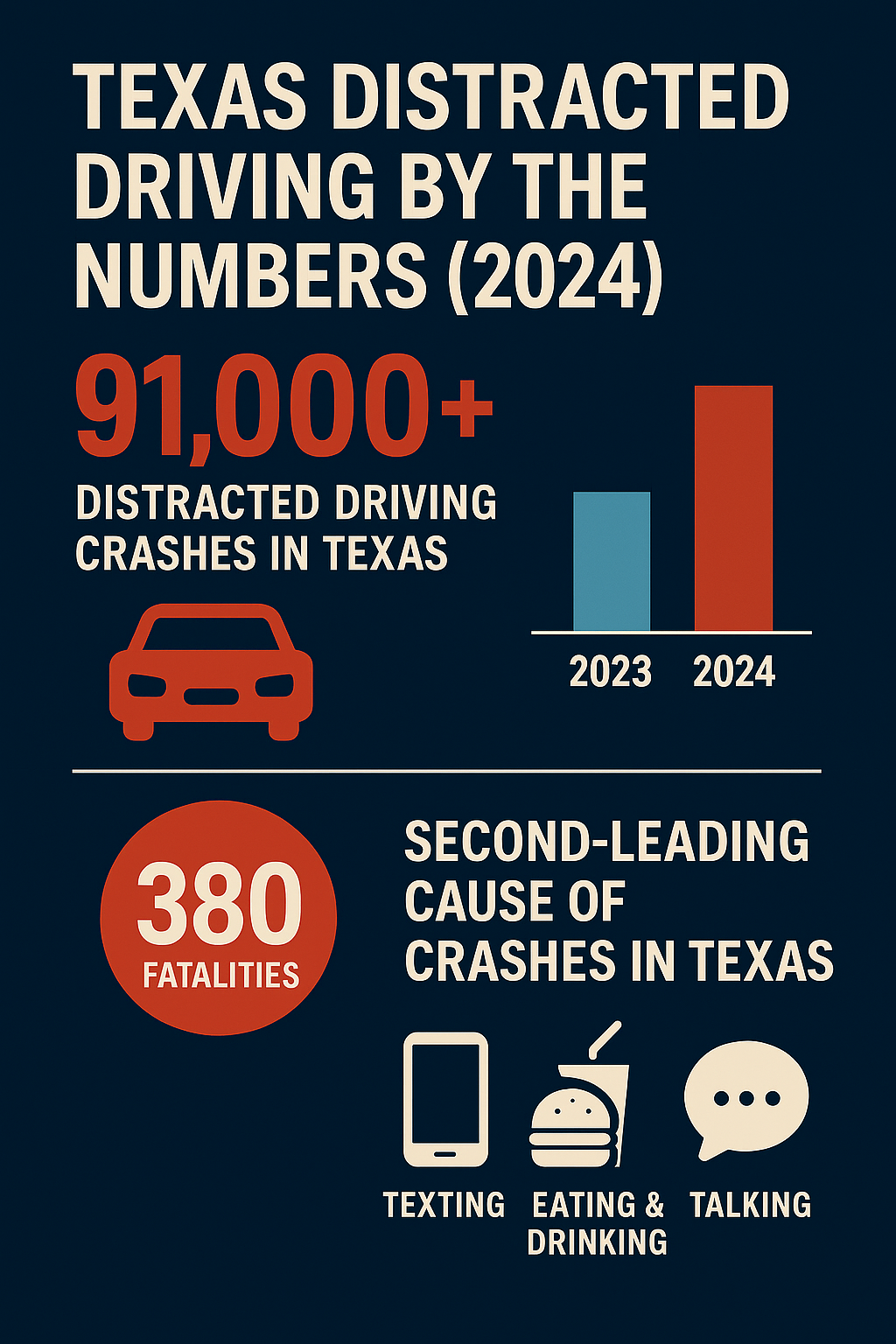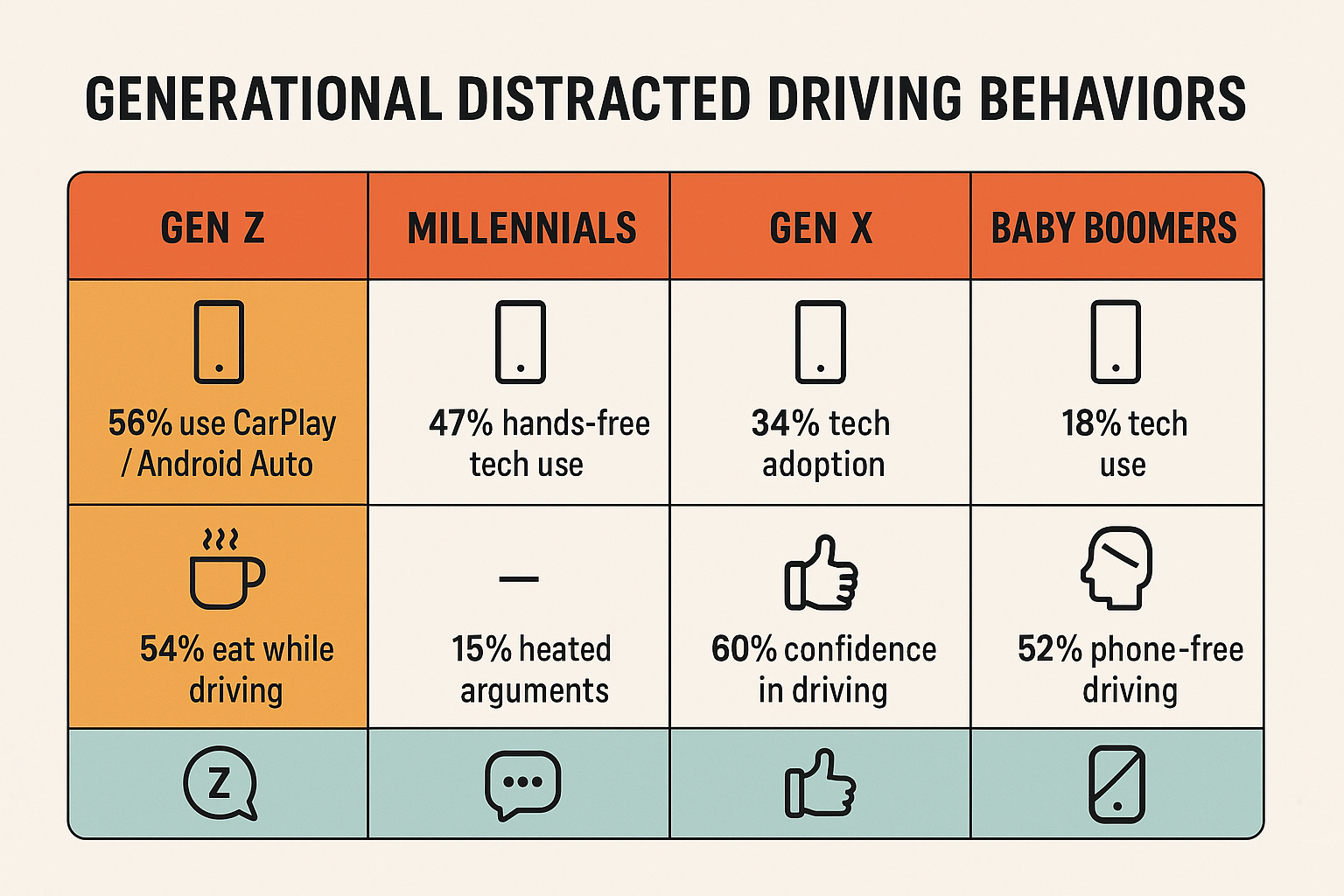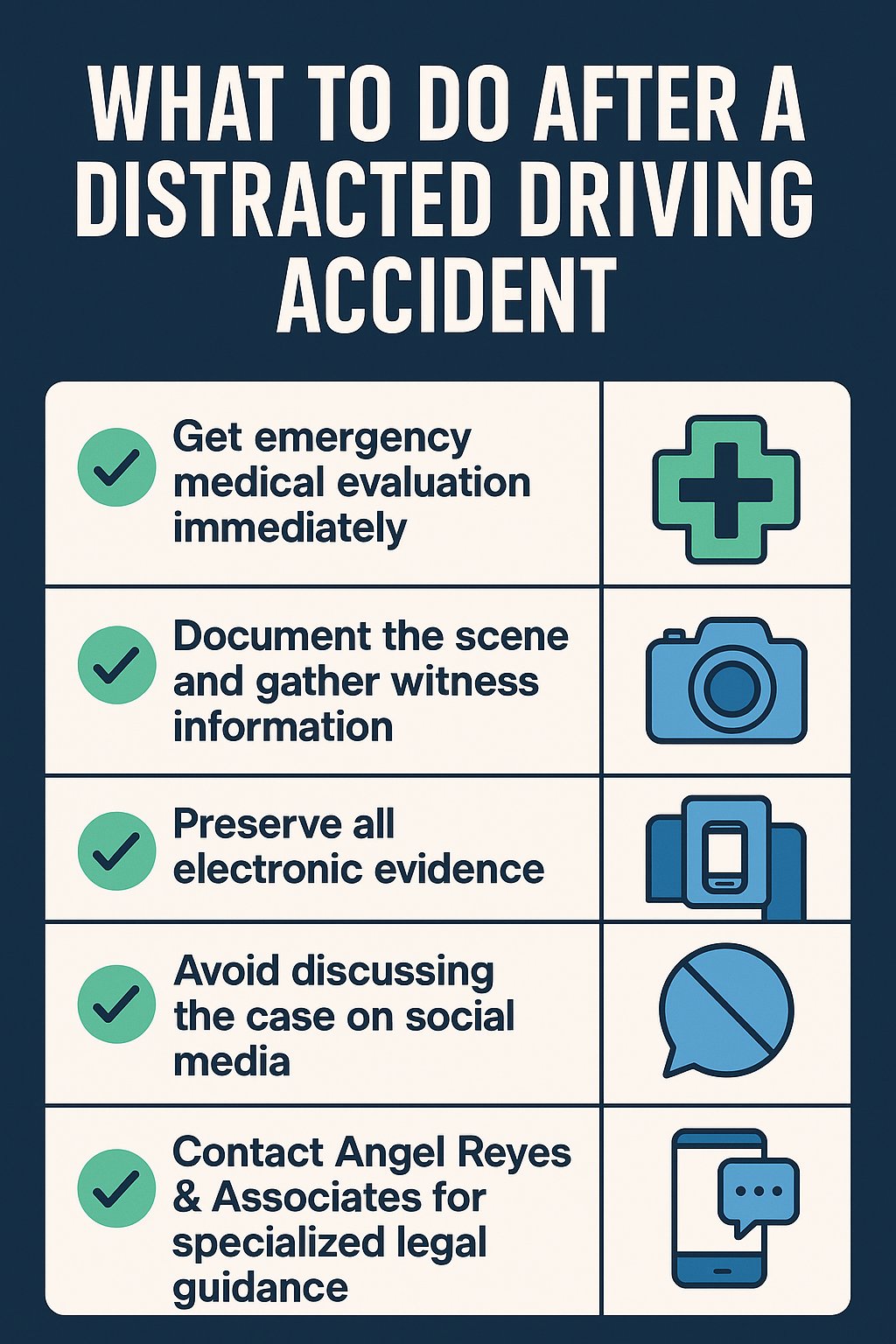Distracted Driving Accidents in Texas: The Growing Crisis and Your Legal Rights
With distracted driving becoming the second-leading cause of crashes in Texas and claiming 380 lives in 2024 alone, understanding your legal rights and the complex evidence needed to prove these cases has never been more critical.
This comprehensive guide reveals the shocking scope of Texas’s distracted driving epidemic and provides essential information about pursuing compensation from negligent drivers who put convenience over safety.
Legal Rights and Compensation for Distracted Driving Accident Victims in Texas
Distracted driving accidents have become a rapidly growing crisis on Texas highways. State data reveals alarming trends that signal a public safety emergency.
These preventable crashes occur when drivers take their attention away from the road to use phones, eat, adjust GPS systems, or engage in other activities. Such behaviors compromise their ability to drive safely.
According to the Texas Department of Transportation (TxDOT), distracted driving is now the second-leading cause of crashes statewide. It accounts for over 91,000 accidents and killed 380 people in 2024.
The crisis affects every corner of Texas. Dallas County experiences the highest concentration of these preventable accidents, followed by Travis and Harris counties.
Victims of distracted driving accidents have strong legal rights to compensation from negligent drivers. Texas law protects those harmed by drivers who choose to prioritize distractions over road safety.
Understanding the Data Behind the Crisis
This analysis combines multiple authoritative data sources. It provides a comprehensive view of Texas’s distracted driving crisis.
Primary Data Sources:
TxDOT Crash Data (2024): Official state statistics on distracted driving accidents, fatalities, and geographic distribution across Texas counties and highways.
Talker Research National Survey: Comprehensive analysis of 2,000 drivers examining generational differences in distracted driving behaviors and technology usage patterns.
Nationwide Insurance Research: National studies on distracted driving trends and safety technology adoption across different age demographics.
Supporting Analysis:
Angel Reyes & Associates case data shows regional distribution patterns. These align with state trends.
Federal highway safety statistics provide comparative context.
Insurance industry reports detail claim patterns and liability issues.
By blending official state crash data with behavioral research and real-world legal experience, this analysis provides both the statistical foundation and practical implications. It reveals the scope of Texas’s distracted driving epidemic.

The Alarming Rise of Distracted Driving in Texas
Texas is experiencing an unprecedented surge in distracted driving accidents. Official state statistics and national behavioral research paint a disturbing picture of normalized dangerous driving practices.
The combination of smartphone proliferation, busier lifestyles, and cultural acceptance of multitasking has created conditions for preventable crashes. These crashes devastate families across the state.
Statewide Statistics Paint a Grim Picture
TxDOT data reveals that distracted driving accidents have reached crisis levels. Over 91,000 crashes involving distracted drivers occurred in 2024 alone.
These crashes resulted in 380 deaths and thousands of serious injuries. This cements distracted driving as the second-leading cause of accidents statewide.
The 4.4% increase in distracted driving cases from 2023 to 2024 represents a troubling trend. It shows no signs of slowing.
This increase comes despite widespread awareness campaigns and legal penalties. It indicates that drivers continue to prioritize convenience over safety.
The Human Cost Behind the Statistics
Behind every statistic is a family whose life was changed forever. Someone’s decision to text, eat, or engage in other distractions while driving caused this change.
The 380 people who died in distracted driving crashes in 2024 represent parents, children, and loved ones. Their lives were cut short by entirely preventable accidents.
The thousands of injured victims face medical bills, lost wages, and permanent disabilities. This happens because other drivers couldn’t wait to check their phones or finish their meals.
These consequences ripple through families and communities. They create lasting trauma that extends far beyond the immediate crash victims.
Most Dangerous Counties and Highways for Distracted Driving
Geographic analysis of TxDOT crash data reveals patterns. Urban counties and major highway corridors experience the highest concentrations of these preventable crashes.
Understanding these patterns helps identify where the crisis is most severe. It also shows where victims are most likely to need legal representation.
Top Counties for Distracted Driving Accidents
Dallas County leads Texas in distracted driving accidents. This reflects the county’s dense population and complex highway system.
The county includes major cities like Dallas, Irving, Garland, and Mesquite. These are all connected by busy highways like I-635, I-30, and I-35 where distracted driving creates deadly conditions.
Travis County follows as a major hotspot. It’s primarily concentrated in the Austin metropolitan area where rapid growth and heavy I-35 traffic contribute to frequent distracted driving incidents.
Harris County accounts for significant numbers in the Houston area. The county’s massive size and notorious traffic congestion create dangerous conditions.
Other high-risk counties include Collin, Bexar, Tarrant, and Denton counties. These numbers reflect the concentration of distracted driving problems in major metropolitan areas with heavy traffic volumes.
Most Dangerous Highways
Highway 35 leads all Texas highways in distracted driving cases. This reflects its role as a major corridor through the state’s largest cities.
Highway 30 and Highway 635 also show concerning accident concentrations.
Highway 20 and Highway 10 demonstrate how both major urban highways and cross-state corridors create dangerous conditions. These highways’ combination of high speeds and heavy traffic makes momentary inattention particularly deadly.
Understanding Different Types of Distracted Driving
Distracted driving encompasses far more than just texting while driving. It involves any activity that takes a driver’s attention away from the primary task of operating a vehicle safely.
National safety research identifies three distinct categories of distractions. These help establish liability and demonstrate the various ways that negligent drivers cause preventable accidents.
Visual Distractions That Take Eyes Off the Road
Visual distractions occur when drivers look away from the road to focus on something else. This creates dangerous gaps in attention that can last several seconds.
Common visual distractions include reading or sending text messages and checking GPS navigation systems. They also include looking at passengers during conversations and adjusting mirrors or other vehicle controls.
Even brief visual distractions can have devastating consequences at highway speeds. A driver looking at their phone for just two seconds travels approximately 150 feet at 50 mph without watching the road ahead.
Manual Distractions That Remove Hands from the Wheel
Manual distractions involve taking one or both hands off the steering wheel to perform other tasks. This reduces the driver’s ability to maintain control of the vehicle.
These distractions include eating or drinking while driving and adjusting radio or climate controls. They also include reaching for objects in the vehicle and grooming activities like applying makeup or shaving.
The loss of vehicle control from manual distractions becomes particularly dangerous during sudden emergencies. Drivers need both hands to steer around obstacles or maintain control during evasive maneuvers.
Cognitive Distractions That Divert Mental Attention
Cognitive distractions occur when drivers’ minds are not focused on driving. This happens even when their eyes are on the road and hands are on the wheel.
These distractions include hands-free phone conversations and intense emotional discussions with passengers. They also include daydreaming or being lost in thought and stress from personal or work problems.
Research shows that cognitive distractions can be just as dangerous as visual or manual distractions. The brain cannot fully process driving-related information when attention is divided.
Technology-Related Distractions
Modern technology has created new categories of distractions that didn’t exist for previous generations of drivers. These include smartphone usage for calls, texts, and social media.
Other technology distractions include GPS navigation system adjustments, entertainment system controls, and in-vehicle communication systems.
While some technology can enhance safety when used properly, the temptation to interact with devices while driving has created a new category of preventable accidents. This category continues to grow each year.
Generational Differences in Distracted Driving Behavior

National research reveals that different generations exhibit distinct patterns of distracted driving behavior. Each age group faces unique risks and challenges that affect their likelihood of causing accidents.
Understanding these generational differences helps establish patterns of negligence. It demonstrates how cultural attitudes toward multitasking have influenced driving behavior.
Generation Z: Technology-Savvy but Risk-Taking
Generation Z drivers demonstrate a paradoxical relationship with technology and driving safety. They use car-specific safety features more than any other generation while also engaging in high-risk behaviors.
Despite using CarPlay and Android Auto at rates of 56% compared to just 18% of Baby Boomers, Gen Z drivers also exhibit concerning patterns. They show high rates of non-technology distractions.
Talker Research data shows that 54% of Gen Z drivers admit to eating while driving. This is significantly higher than older generations.
Additionally, 32% drive while tired, and 64% use their phones for music while driving. However, they often do this through safer hands-free systems.
Millennials: The Multitasking Generation
Millennial drivers exhibit balanced technology use with traditional safety awareness. They use hands-free technology at rates of 47% while maintaining awareness of safety risks.
However, this generation shows concerning patterns of emotional distraction. 15% report heated arguments while driving.
Millennials represent the transition between traditional driving habits and modern technology integration. Their approach to distracted driving often involves attempting to multitask efficiently rather than focusing solely on driving.
Generation X: Adapting to Modern Challenges
Generation X drivers show moderate technology adoption. 34% use car tech features, representing a middle ground between younger and older generations.
This generation maintains 60% confidence in their driving abilities. They adapt to new technology at a measured pace.
Their distracted driving patterns often involve trying to balance traditional driving habits with modern technology demands. This can create situations where they’re neither fully comfortable with new technology nor completely focused on traditional driving skills.
Baby Boomers: Traditional Focus with Technology Resistance
Baby Boomers demonstrate the lowest rates of technology-related distractions. Only 18% use modern car tech features and 63% never enable safety features like Drive Mode.
While this generation shows the highest rates of phone-free driving at 52%, their resistance to safety technology may create its own risks.
Their distracted driving incidents often involve traditional distractions like eating, drinking, or passenger conversations. These occur rather than technology-related activities.
However, their unfamiliarity with modern safety features means they may not benefit from technologies designed to prevent accidents.
Legal Liability and Compensation for Distracted Driving Accidents
Texas law holds distracted drivers fully accountable for the consequences of their negligent behavior. It provides victims with strong legal grounds for pursuing compensation.
The state’s comparative negligence system allows victims to recover damages even if they bear some responsibility for the accident. This applies as long as they are less than 51% at fault.
Establishing Negligence in Distracted Driving Cases
Proving negligence in distracted driving cases requires demonstrating that the driver breached their duty of care. They did this by engaging in distracting activities while operating a vehicle.
Evidence of distracted driving can include cell phone records, witness testimony, surveillance footage, and the driver’s own admissions. These show their activities at the time of the crash.
Texas law recognizes that drivers have a fundamental duty to pay attention to the road. They must avoid activities that compromise their ability to drive safely.
When drivers violate this duty by texting, eating, or engaging in other distractions, they become liable for all resulting damages.
Types of Compensation Available
Victims of distracted driving accidents can pursue comprehensive compensation. This addresses both immediate and long-term consequences of their injuries.
Medical expenses include emergency treatment, surgeries, rehabilitation, and ongoing care. These cover permanent disabilities caused by the negligent driver’s inattention.
Lost wages compensation covers both immediate income loss during recovery and reduced earning capacity. This applies when injuries prevent victims from returning to their previous employment.
Pain and suffering damages address the physical discomfort, emotional trauma, and reduced quality of life. These result from preventable accidents.
Punitive Damages for Egregious Behavior
Texas law allows punitive damages in cases where distracted driving demonstrates gross negligence. It also applies when there’s willful disregard for safety.
These damages punish particularly dangerous behavior and deter future violations. They make the financial consequences severe enough to change behavior patterns.
Repeat offenders, drivers who cause fatal accidents while texting, or those who show a pattern of distracted driving behavior may face punitive damages. These significantly exceed compensatory awards.
These damages serve both punishment and deterrence purposes in the legal system.
Insurance Company Tactics and Challenges
Insurance companies often attempt to minimize distracted driving claims. They argue that other factors contributed to the accident or that the victim’s injuries are not as severe as claimed.
They may also try to shift blame to the victim. They might argue that the distracted behavior was not the proximate cause of the crash.
Experienced attorneys know how to counter these tactics by preserving crucial evidence. They work with accident reconstruction experts and present compelling cases that demonstrate the full impact of the defendant’s negligent behavior.
Early legal intervention often prevents insurance companies from successfully minimizing legitimate claims.
Why Distracted Driving Cases Require Specialized Legal Expertise
Distracted driving cases involve complex technical evidence, multiple forms of proof, and sophisticated legal arguments. They require specialized knowledge and immediate action.
These cases demand attorneys who understand both the technology involved in modern distractions and the legal principles that govern negligence claims.
Evidence Preservation and Technical Analysis
Modern distracted driving cases often involve electronic evidence that can disappear quickly if not properly preserved. Cell phone records, GPS data, social media activity, and vehicle computer systems all provide crucial evidence about the driver’s actions at the time of the crash.
Attorneys must act quickly to send preservation notices to phone companies and social media platforms. This must happen before evidence is automatically deleted.
Technical experts may be needed to analyze phone data, vehicle computer systems, and other electronic evidence. This demonstrates distracted driving behavior.
Medical Documentation and Future Care Planning
Distracted driving accidents often cause severe injuries due to the sudden nature of the crashes and the high speeds involved. Victims may suffer traumatic brain injuries, spinal cord damage, and other catastrophic injuries that require extensive medical treatment and long-term care.
Specialized attorneys work with medical experts to document the full extent of injuries and project future care needs. This includes working with life care planners, economists, and rehabilitation specialists to calculate the true cost of lifetime care and support.
Multi-Party Liability and Complex Insurance Issues
Some distracted driving cases involve multiple liable parties. These include the distracted driver, their employer (if driving for work), and potentially manufacturers of defective safety equipment.
Commercial drivers who cause accidents while distracted may create liability for trucking companies. This happens when companies fail to enforce safety policies.
Understanding commercial insurance policies, employment relationships, and corporate liability requires specialized knowledge. Most attorneys don’t possess this knowledge.
These cases often involve multiple insurance companies and complex coverage issues. These affect the total compensation available.
Negotiation and Trial Advocacy
Insurance companies take distracted driving cases seriously. They often assign experienced defense attorneys to minimize settlements.
Successful representation requires attorneys who understand how to present complex technical evidence to juries. They must also negotiate effectively with sophisticated insurance defense teams.
How Angel Reyes & Associates Handles Distracted Driving Cases
At Angel Reyes & Associates, we combine immediate evidence preservation with comprehensive case development. We build compelling distracted driving claims.
Our team works with technical experts, medical specialists, and accident reconstruction professionals. We demonstrate the full impact of negligent behavior.
We understand the unique challenges of distracted driving cases. We know how to counter insurance company tactics designed to minimize settlements.
Our growing experience with these complex claims reflects the statewide trend documented in TxDOT data. This provides us with the strategies needed to maximize compensation.
At Angel Reyes & Associates, we bring 30+ years of experience, a client-first approach, and a relentless drive to fight for your rights. We offer no upfront costs, you only pay if we win, and we provide personalized legal guidance every step of the way.
What Should You Do After a Distracted Driving Accident?
Protecting your health and legal rights after a distracted driving accident requires immediate action and careful documentation. The evidence needed to prove distracted driving can disappear quickly.
This makes early legal intervention crucial for successful claims.
Immediate Medical Care and Safety
Get emergency medical care immediately, even if you feel fine after the accident. The adrenaline and shock from crashes can mask serious injuries that become apparent only after professional medical evaluation.
Distracted driving accidents often cause severe injuries due to the sudden nature of the impacts and the high speeds involved. Prompt medical attention ensures proper treatment and creates important documentation for your legal case.
Document the Scene and Gather Evidence
If you’re able, take photographs of all vehicles involved, visible damage, and the accident scene. Document any evidence of distracted driving, such as phones visible in vehicles, food containers, or other items that suggest the driver was engaged in distracting activities.
Gather witness contact information from other drivers who may have observed the distracted behavior before the crash. Multiple witnesses often notice distracted driving patterns that become crucial evidence for legal claims.
Preserve Electronic Evidence
Do not discuss the accident on social media or allow the other driver to delete any evidence from their phone or vehicle. Electronic evidence can be crucial for proving distracted driving, but it disappears quickly if not properly preserved.
Ask police officers to note any observations about possible distracted driving behavior in their report. This official documentation can provide important evidence for your case.
Avoid Insurance Company Traps
Insurance adjusters will contact you quickly after distracted driving accidents. They often try to minimize their driver’s distracted behavior or shift blame to you.
Avoid giving recorded statements or accepting quick settlement offers without legal representation.
Insurance companies may try to argue that other factors caused the accident. They might claim that their driver was not actually distracted.
Let experienced attorneys handle all communications with insurance companies to protect your rights.
Seek Immediate Legal Help
Contact experienced legal help immediately after distracted driving accidents. These cases require specialized knowledge of electronic evidence preservation, technical analysis, and complex liability issues that most attorneys don’t possess.
Don’t try to handle these claims alone against insurance companies. These companies have teams of experienced adjusters and attorneys working to minimize settlements.
The statewide increase in distracted driving cases documented by TxDOT demonstrates the growing complexity of these claims.

“Distracted driving represents inexcusable negligence that endangers everyone on Texas roads. With TxDOT data showing over 91,000 crashes and 380 deaths in 2024, the crisis is growing worse each year. You don’t have to face the legal battle alone—let Angel Reyes & Associates fight for the compensation you deserve.”
Frequently Asked Questions About Distracted Driving Accidents
What constitutes distracted driving under Texas law?
Distracted driving includes any activity that takes attention away from driving, including texting, eating, adjusting GPS systems, or engaging in intense conversations. Texas law prohibits texting while driving with fines up to $200.
How do you prove the other driver was distracted during an accident?
Evidence includes cell phone records, witness testimony, surveillance footage, physical evidence like food containers, and the driver’s own statements. Electronic evidence must be preserved quickly before it’s deleted.
What compensation can I recover after a distracted driving accident?
Victims can seek medical expenses, lost wages, pain and suffering, and property damage. Punitive damages may be available for particularly egregious distracted driving behavior.
How has distracted driving changed in Texas recently?
TxDOT data shows Texas recorded 91,000+ distracted driving crashes in 2024, with 380 fatalities, representing a 4.4% increase from 2023. This makes distracted driving the second-leading cause of crashes statewide.
Why do I need a specialized attorney for distracted driving cases?
These cases involve complex electronic evidence, technical analysis, and sophisticated insurance defense tactics. Specialized attorneys understand how to preserve crucial evidence and counter insurance company strategies.
Sources
Talker Research National Driving Survey, 2024
Texas Department of Transportation (TxDOT), 2024 Crash Statistics Report
TxDOT Geographic Crash Data Analysis, 2024
National Highway Traffic Safety Administration, Distracted Driving Research
















